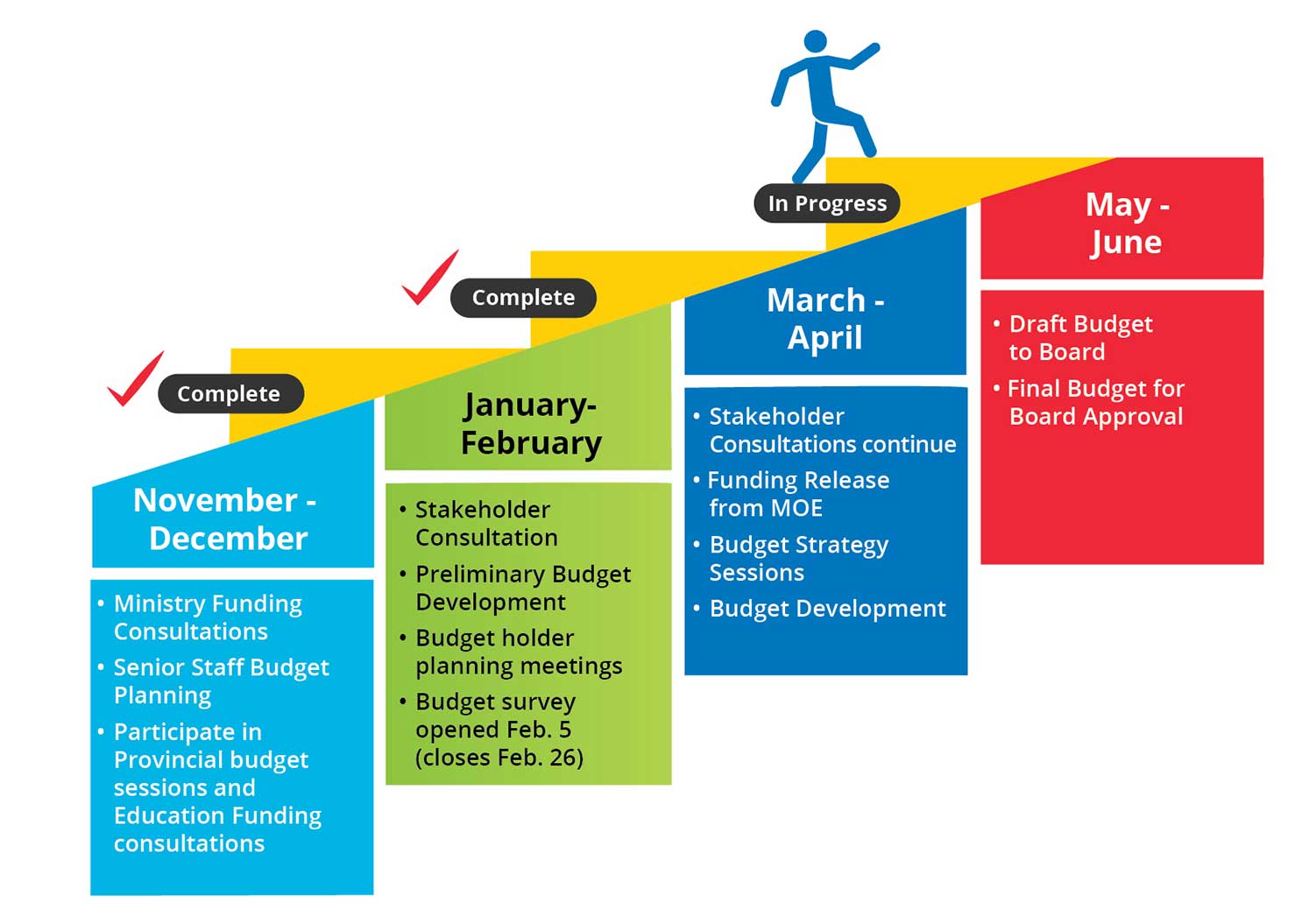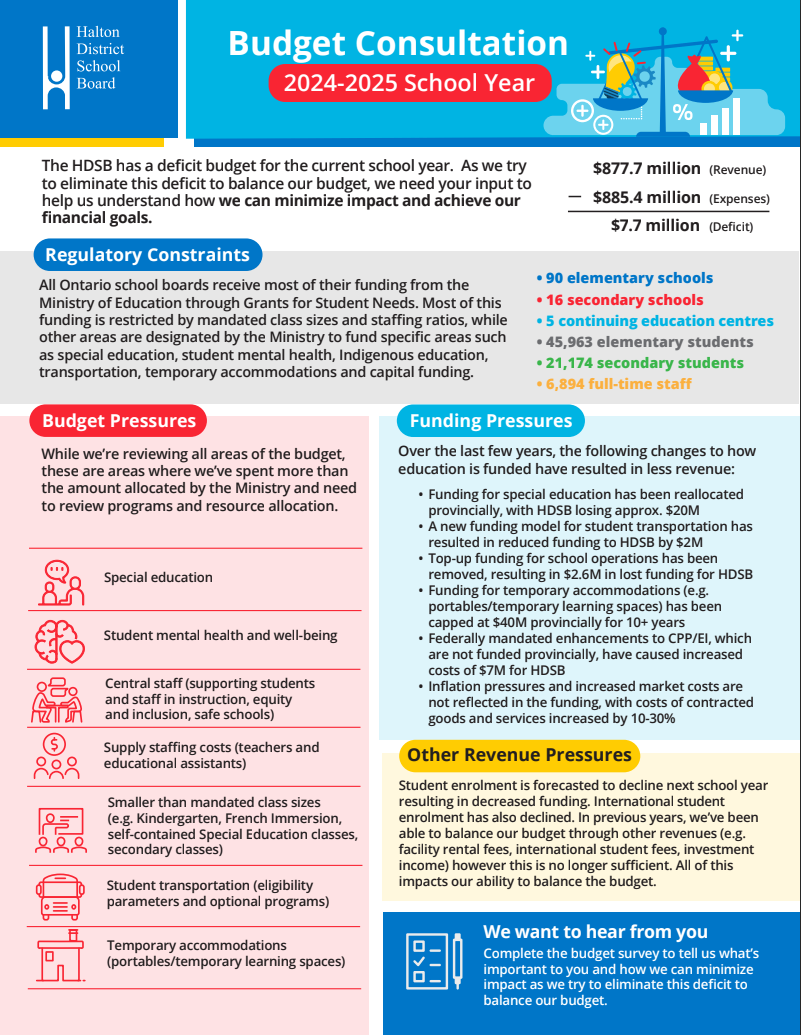The Halton District School Board (HDSB) invited parents/guardians, students, staff and community members to provide input into the budget development process for the 2024-2025 school year.
The survey closed on Feb. 26, 2024
Over the past few years, the education sector has been presented with unprecedented challenges and funding pressures. It is also expected that elementary and secondary student enrolment in the region will decline next year. With student enrolment as the main driver of funding for the school board, this will result in lost revenue. The HDSB has budgeted for a $7.7 million deficit in the current year and is required by regulation to eliminate this deficit next school year (2024-2025). We are looking to identify savings and efficiencies to meet the regulatory requirement to balance our budget, while continuing to make investments in strategic priorities.
The budget development process aligns the allocation of resources to the HDSB’s strategic priorities, as identified in the 2020-2024
Multi-Year Plan and the annual operating plan.
How Our School Board is Funded
The HDSB receives the majority of its funding from the province through Grants for Student Needs. Most of this funding is restricted by mandated class sizes and staffing ratios, while other areas are designated by the Ministry to fund specific areas. The main areas where funding is restricted to specific use include: special education, student mental health, indigenous education, transportation, temporary accommodations and capital funding. Learn more about how school boards receive funding by visiting the
Ministry of Education webpage.
The 2024-2025 budget process and timelines are summarized below, and details will be added to the
Budget and Financial Information webpage as information becomes available:
HDSB’s 2024-2025 Budget Process & Timelines
November - December: Complete
- Ministry Funding Consultations
- Senior Staff Budget Planning
- Participate in Provincial budget sessions and Education Funding consultations
January - February: Complete
- Stakeholder Consultation
- Preliminary Budget Development
- Budget holder planning meetings
- Budget survey opened Feb. 5 (closes Feb. 26)
March - April: Complete
- Stakeholder Consultations continue
- Funding Release from MOE
- Budget Strategy Sessions
- Budget Development
May - June: Complete
- Draft Budget to Board
- Final Budget for Board Approval

Budget Consultation - 2024-2025 School Year
The HDSB has a deficit budget for the current school year. As we try to eliminate this deficit to balance our budget, we need your input to help us understand how we can minimize impact and achieve our financial goals.
$877.7 million (Revenue ) - $885.4 million (Expenses) = $7.7 million (Deficit)
Regulatory Constraints
All Ontario school boards receive most of their funding from the Ministry of Education through Grants for Student Needs. Most of this funding is restricted by mandated class sizes and staffing ratios, while other areas are designated by the Ministry to fund specific areas such as special education, student mental health, Indigenous education, transportation, temporary accommodations and capital funding.
- 90 elementary schools
- 16 secondary schools
- 5 continuing education centres
- 45,963 elementary students
- 21,174 secondary students
- 6,894 full-time staff
Budget Pressures While we’re reviewing all areas of the budget, these are areas where we’ve spent more than the amount allocated by the Ministry and need to review programs and resource allocation.
- Special education
- Student mental health and well-being
- Central staff (supporting students and staff in instruction, equity and inclusion, safe schools)
- Supply staffing costs (teachers and educational assistants)
- Smaller than mandated class sizes (e.g. Kindergarten, French Immersion, self-contained Special Education classes, secondary classes)
- Student transportation (eligibility parameters and optional programs)
- Temporary accommodations (portables/temporary learning spaces)
Funding Pressures Over the last few years, the following changes to how education is funded have resulted in less revenue:
- Funding for special education has been reallocated provincially, with HDSB losing approx. $20M
- A new funding model for student transportation has resulted in reduced funding to HDSB by $2M
- Top-up funding for school operations has been removed, resulting in $2.6M in lost funding for HDSB
- Funding for temporary accommodations (e.g. portables/temporary learning spaces) has been capped at $40M provincially for 10+ years
- Federally mandated enhancements to CPP/EI, which are not funded provincially, have caused increased costs of $7M for HDSB
- Inflation pressures and increased market costs are not reflected in the funding, with costs of contracted goods and services increased by 10-30%
Other Revenue PressuresStudent enrolment is forecasted to decline next school year resulting in decreased funding. International student enrolment has also declined. In previous years, we’ve been able to balance our budget through other revenues (e.g. facility rental fees, international student fees, investment income) however this is no longer sufficient. All of this impacts our ability to balance the budget.

View current year
Enrolment, Revenues and Expenses which will form the basis of the 2024-2025 budget process. Details on the prior year's budget and financial statements can be found on the
Budget and Financial Information webpage.